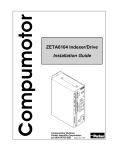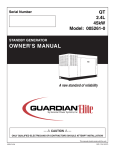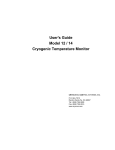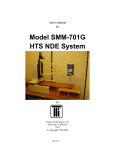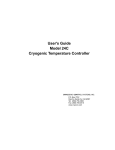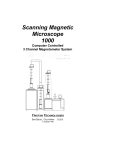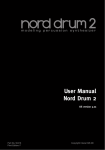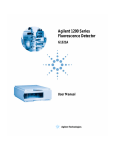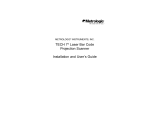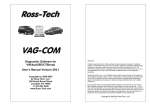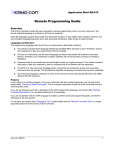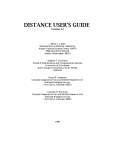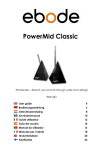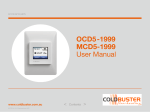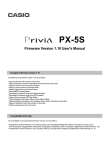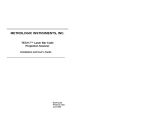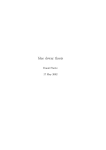Download Model SMM-770 HTS Scanning Magnetic Microscope
Transcript
Scanning Magnetic Microscope Model SMM-770 Operating Guide TRISTAN TECHNOLOGIES, Inc San Diego, California USA www.tristantech.com Model SMM 770 Scanning Magnetic Microscope System Operating Guide for Single channel HTS SQUID microscope Model SMM-770 Option 77P, 77V, 77T, 77B, 77HR, MS-770 TRISTAN TECHNOLOGIES, Inc San Diego, California USA © Copyright 2005 www.tristantech.com TRISTAN TECHNOLOGIES --Page 2 Model SMM 770 Scanning Magnetic Microscope System Revision Record Date Revision Description May 6, 2005 Version 1. Initial Release May 11, 2005 Version 1.1 actual data included May 31, 2005 Version 1.2 more data © 2005 by Tristan Technologies All rights reserved. No part of this manual may be reproduced, stored in a retrieval system, or transmitted in any form or by any means, electronic, mechanical, photocopying, recording, or otherwise, without prior written permission of TRISTAN TECHNOLOGIES Inc. TRISTAN TECHNOLOGIES Inc. reserves the right to change the functions, features, or specifications of its products at any time, without notice. Any questions or comments in regard to this product and other products from Tristan Technologies, please contact or see http://www.tristantech.com: Tristan Technologies 6191 Cornerstone Ct. East., Suite 107 San Diego, CA 92121 U. S. A. Technical Support: (858) 550 – 2700 FAX: (858) 550 – 2799 [email protected] http://www.tristantech.com TRISTAN TECHNOLOGIES --Page 3 Model SMM 770 Scanning Magnetic Microscope System WARRANTY TRISTAN TECHNOLOGIES Limited Warranty TRISTAN TECHNOLOGIES Inc. warrants this product for a period of twelve (12) months from date of original shipment to the customer. Any part found to be defective in material or workmanship during the warranty period will be repaired or replaced without charge to the owner. Prior to returning the instrument for repair, authorization must be obtained from TRISTAN TECHNOLOGIES Inc. or an authorized TRISTAN TECHNOLOGIES service agent. All repairs will be warranted for only the unexpired portion of the original warranty, plus the time between receipt of the instrument at TRISTAN TECHNOLOGIES and its return to the owner. This warranty is limited to TRISTAN TECHNOLOGIES’ products that are purchased directly from TRISTAN TECHNOLOGIES, its OEM suppliers, or its authorized sales representatives. It does not apply to damage caused by accident, misuse, fire, flood or acts of God, or from failure to properly install, operate, or maintain the product in accordance with the printed instructions provided. This Warranty Is In Lieu Of Any Other Warranties, Expressed Or Implied, Including Merchantability Or Fitness For Purpose, Which Are Expressly Excluded. The Owner Agrees That TRISTAN TECHNOLOGIES’ Liability With Respect To This Product Shall Be As Set Forth In This Warranty, and Incidental Or Consequential Damages Are Expressly Excluded. TRISTAN TECHNOLOGIES --Page 4 Model SMM 770 Scanning Magnetic Microscope System Table of Contents 1. SYSTEM OVERVIEW 10 1.1 INITIAL INSPECTION 12 1.2 REPACKING FOR RETURN SHIPMENT 12 1.3 RETURN FROM CUSTOMERS OUTSIDE THE U.S.A. 12 1.4 SYSTEM COMPONENTS 12 2. CRYOGENIC SYSTEM 16 2.1 LIQUID NITROGEN MAINTENANCE 17 2.2 NORMAL INSTALLATION AND OPERATION 17 2.3 SAFETY PRECAUTIONS FOR HANDLING CRYOGENIC LIQUIDS 17 2.4 GENERAL INFORMATION 19 3. SENSORS AND CONTROL ELECTRONICS 20 3.1 WIRING DIAGRAM 20 3.2 SENSOR INITIAL PERFORMANCE TEST 22 3.3 MEASURED PARAMETERS AND FACTORY TEST DATA 22 3.4 SENSOR CALIBRATION 25 4. SYSTEM SOFTWARE 31 4.1 START 31 4.2 EXCITATION 33 4.3 TRACK CONSTRUCTION 33 4.4 MOVE MANUALLY 35 4.5 SQUID PARAMETERS 36 4.6 ACQUISITION PARAMETERS 37 4.7 FILTER PARAMETERS 38 4.8 SCAN CONTROLS 39 4.9 OUTPUT FILE 46 4.10 VIDEO CAMERA 50 TRISTAN TECHNOLOGIES --Page 5 Model SMM 770 Scanning Magnetic Microscope System 5. SERVICE AND MAINTENANCE 51 5.1 INSPECTION AND CLEANING 51 5.2 CRYOGENIC DEWAR MAINTENANCE 51 5.3 GANTRY MAINTENANCE 53 5.4 VIBRATION ISOLATION EQUIPMENT 53 6. OPTIONAL EQUIPMENT 53 6.1 OPTION 77P PNEUMATIC VIBRATION ISOLATION 53 6.2 OPTION 77V ACTIVE VIBRATION CANCELLATION 53 6.3 OPTION 77T TILT TIP FRAME 54 6.4 OPTION 77B FIXED FIELD CAPABILITY 55 6.5 OPTION 77HR 12.5 MICRON STEP CAPACITY 59 6.6 OPTION MS-770 TWO LAYER MU METAL MAGNETIC SHIELD 59 7. APPENDICES 62 7.1 THERMOMETRY AND COOLDOWN 62 7.2 CALCULATING B-FIELDS 63 7.3 WIRING AND HARDWARE CONFIGURATION 66 7.4 BACKGROUND SUBTRACTION 73 7.5 STAGE CALIBRATION 74 8. HTS SQUID HANDLING CAUTIONS 75 Table of Figures Figure 1-1: SQUID System.................................................................................................. 10 Figure 1-2: Microscope Setup.............................................................................................. 11 Figure 2-1: Cryogenic Dewar .............................................................................................. 16 Figure 3-1 Overview of SMM770 wiring diagram.............................................................. 20 Figure 3-2 SMM770 detailed wiring diagram ..................................................................... 21 Figure 3-3: Manufacturer-supplied noise spectrum and tune specs..................................... 22 Figure 3-4 SQUID noise spectrum at (0-200Hz), 81.8 Kelvin, gain=x100......................... 24 Figure 3-5 SQUID noise spectrum at (0-3.2 kHz), 81.8 Kelvin, gain=x100....................... 24 TRISTAN TECHNOLOGIES --Page 6 Model SMM 770 Scanning Magnetic Microscope System Figure 3-6 SQUID noise spectrum at (0-12.8 kHz), 81.8 Kelvin, gain=x100..................... 25 Figure 3-7: Horizontal Scan of parallel wires 0.003" apart. ................................................ 26 Figure 3-8: Horizontal scans at increasing liftoffs to parallel wires 0.009” apart. .............. 26 Figure 3-9: Vertical Scan of parallel wires 0.009" apart ..................................................... 27 Figure 3-10: Vertical scan of parallel wires 0.003" apart.................................................... 27 Figure 3-11: Central peak of a horizontal scan across 76 micron separation meander coil 28 Figure 3-12: US Dollar bill .................................................................................................. 29 Figure 3-13: Image showing what a small amount of processing can accomplish.............. 29 Figure 3-14:: The following output of data is a 3D post processing of the image shown in Figure 3-11...................................................................................................................... 30 Figure 4-1: Selection of Initialization file............................................................................ 31 Figure 4-2: Main panel after system start ............................................................................ 32 Figure 4-3: Track parameters............................................................................................... 33 Figure 4-4: Preview of track to be used for discrete scanning............................................. 34 Figure 4-5: Preview of QuikScan (continuous) track .......................................................... 35 Figure 4-6: Manual control of the sample stage .................................................................. 36 Figure 4-7: iMAG SQUID parameters................................................................................. 37 Figure 4-8: Data acquisition parameters .............................................................................. 38 Figure 4-9: Filter parameters ............................................................................................... 39 Figure 4-10: Scan controls ................................................................................................... 40 Figure 4-11: View of scan track........................................................................................... 41 Figure 4-12: Generation of stripchart and 3D graph............................................................ 42 Figure 4-13: Contour lines in the 3D plot............................................................................ 43 Figure 4-14: Cursor usage in the 3D plot............................................................................. 44 Figure 4-15 Illumination control in the 3D plot................................................................... 45 Figure 4-16: Z-axis control .................................................................................................. 46 Figure 4-17: File saving and loading ................................................................................... 47 Figure 4-18 Example data file.............................................................................................. 48 Figure 4-19: Deletion of data files ....................................................................................... 49 Figure 4-20 Gap between the windown and sample as seen by the video camera .............. 50 Figure 5-1 Measured boil off rate ........................................................................................ 52 Figure 6-1 Passive Newport table vs. Newport table with the Activator installed in a horizontal configuration.................................................................................................. 54 TRISTAN TECHNOLOGIES --Page 7 Model SMM 770 Scanning Magnetic Microscope System Figure 6-2 Passive Newport table vs. Newport table with activator and without activators and load of 500lbs........................................................................................................... 54 Figure 6-3 Magnet test ring (option 77B) ............................................................................ 56 Figure 6-4 Field profile along Z axis of magnetic ring........................................................ 56 Figure 6-5 Field profile along y and x axis of magnetic ring .............................................. 57 Figure 6-6: x100 Noise spectra of SMM-770 system with 5.5 Gauss external applied field, Gain 58 Figure 6-7: x20 Noise spectra of SMM-770 system with 5.5 Gauss external applied field, Gain 59 Figure 6-8: MS770 mu-metal shield engineering drawings. ............................................... 60 Figure 6-9 Option MS-770 two layer mu metal shield ........................................................ 61 Figure 7-1 Elapsed time for SQUID tip coldwon to operating temperatures ...................... 62 Figure 7-2 Unsubtracted background................................................................................... 73 Figure 7-3 Subtracted background....................................................................................... 74 Table of Tables Table 1 System Parameters ..................................................................................................... 23 Table 3-2: SQUID performance tested with iMAG® ................................................................. 23 Table 3-3: Iterative Calibration Results for SMM-770............................................................... 25 Table 4 Pt thermometer calibration ......................................................................................... 62 TRISTAN TECHNOLOGIES --Page 8 Model SMM 770 Scanning Magnetic Microscope System DIRECTIVE 97/23/EC OF THE EUROPEAN PARLIAMENT AND OF THE COUNCIL of 29 May 1997 on the approximation of the laws of the Member States concerning pressure equipment states that “Whereas equipment subject to a pressure of not more than 0,5 bar does not pose a significant hazard due to pressure; whereas there should not therefore be any obstacle to its free movement within the Community; whereas this Directive applies to equipment subject to a maximum allowable pressure exceeding 0,5 bar”. Since the maximum allowable design pressure is less than 0.5 bar, Tristan’s model SM770 is in conformity with DIRECTIVE 97/23/EC. TRISTAN TECHNOLOGIES --Page 9 Model SMM 770 Scanning Magnetic Microscope System 1. SYSTEM OVERVIEW The Model SMM-770 Scanning Magnetic Microscope System is a close spaced HTS SQUID magnetometer system (Figure 1-1) that has been designed and built by Tristan to detect Bz magnetic field. The main system consists of: Liquid nitrogen dewar with HTS SQUID Sensor Scanning stage X-y tilt stage Vibration Isolation table iMAG® SQUID control electronics1, motion control hardware and software, data acquisition hardware and software and a computer system. Flux-Locked Loop iMC-303 SQUID Controller iFL-301-H Liquid Nitrogen Dewar Interface Card(s) Control Computer Software data acquisition, analysis, motion control HTS SQUID dc magnet (BZ) Sample HItachi Camera Non-Magnetic Stand-off X-Y Scanning Table Z X Y note: some optional items shown Figure 1-1: 1 SQUID System iMAG® is a registered trademark of Tristan Technologies, Inc. TRISTAN TECHNOLOGIES --Page 10 Model SMM 770 Scanning Magnetic Microscope System 770 MICROSCOPE SCANNING STATION Z X DEWAR FIBER OPTIC LIGHT Y VIDEO MICROSCOPE SQUID WINDOW SPACER PLATE (OPTIONAL) X-Y MICRO TILT STAGE Z-AXIS, MANUAL Z-AXIS DIGITAL READOUT X-Y AXIS, MOTORIZED VIBRATION TABLE TOP ACTIVE DAMPING (3 UNITS) VIBRATION ISOLATION AIR TABLE Figure 1-2: Microscope Setup TRISTAN TECHNOLOGIES --Page 11 Model SMM 770 Scanning Magnetic Microscope System 1.1 INITIAL INSPECTION All Tristan Technologies instruments and equipment are carefully inspected and packaged at Tristan Technologies prior to shipment. However, if a unit is received mechanically damaged, notify the carrier and the nearest Tristan Technologies representative, or the factory in San Diego, California. Keep the shipping container and packing material for the carrier and insurance inspections. WARNING USE CARE WHEN HANDLING THE DEWAR. THE SQUID SENSOR IS MOUNTED ON A SPECIAL MECHANISM TO ACCURATELY PLACE THE TIP CLOSE TO THE WINDOW. MISHANDLING MAY CAUSE MISALIGNMENT OF THE SQUID MOUNTING. If the unit does not appear to be damaged but does not operate to specifications, contact the nearest Tristan Technologies representative or the Tristan Technologies factory and describe the problem in detail. Please be prepared to discuss all surrounding circumstances, including installation and connection details. After obtaining authorization from the Tristan Technologies representative, return the unit for repair along with a tag on it identifying yourself as the owner. Please enclose a letter describing the problem in as much detail as possible. 1.2 REPACKING FOR RETURN SHIPMENT If it is necessary to return the system, you should repack the unit in its original container (if available). For this reason, it is advisable to save the original crate sent by Tristan Technologies. However, if this is not possible, use the following instructions for repackaging: 1. Wrap the unit in either bubble wrap or foam rubber 2. Cover the bottom of a sturdy container with at least 3 inches of Styrofoam pellets or shredded paper. 3. Set the unit down onto the packing material and fill the rest of the container with Styrofoam or shredded paper. The unit must be completely protected by at least 3 inches of packing material on all sides. 1.3 RETURN FROM CUSTOMERS OUTSIDE THE U.S.A. To avoid delays in Customs clearance of equipment being returned, contact the Tristan Technologies representative in your area, or the Tristan Technologies factory in San Diego, California, for complete shipping information and necessary customs requirements. Failure to do so can result in significant delays. 1.4 SYSTEM COMPONENTS • Dewar NLD-770 s/n 153 • Option 77P Pneumatic vibration isolation non magnetic microscope table • Option 77V Active vibration cancellation TRISTAN TECHNOLOGIES --Page 12 Model SMM 770 Scanning Magnetic Microscope System • Option 77T Tilt tip frame • Option 77B Fixed field capability • Option 77HR 12.5 micron step capability • Option MS-770 Two layer Mu metal shield • Electronics Rack BNC Adapter: National Instruments, model BNC-2090, s/n 112FBE6 Controller iMAG®, model iMC-303, s/n 001063 GPIB cable Flux-Locked loop (FLL), iFL-301-H s/n2020 Composite fiber optic cable CC-60 Cable SP-7 , HTS Cryogenic Cables (1) Special Cable: Single-Ended BNC to Differential Dual BNC. Motor drive , model MID-7602, s/n E006A6 Motion Controller cable • Computer control and data acquisition system and software Dell Precision PWS370 with dual Pentium 4 2.8 GHz CPUs and 1.00 GB RAM, model WHM, s/n 49YGZ61, service code 9309223945 Windows XP Pro, product key J8C4W-PTCW4-X7JPR-WTBWV-XXYTB GPIB card, National Instruments, model PCI-GPIB, s/n 110EF26 DAQ card, National Instruments, model PCI-6036E, s/n 10ECA27 Motion Control card, National Instruments, model PCI-7342, s/n DF5E03 Video card, National Instruments, model PCI-1405, s/n 111FD9C LabView custom software ,MagScan version 3.0 • Video monitors, 19”: Dell, model DP/N-0G6566, s/n CN-0G6566-47804-51U-U3V2 s/n CN-0G6566-47804-51U-U3MU • Compressor: Jun-Air, model 3-04, s/n 582261 TRISTAN TECHNOLOGIES --Page 13 Model SMM 770 Scanning Magnetic Microscope System • Microscope & Dewar Assembly SQUID sensor mod HTM-0 s/n Mi 10803 7B Fixed DC capability • Microscope gantry: Dewar Vacuum gauge Dunaway DST-531 Laser Ranger; Banner LG10A65PI Readout; Red Lion PAXP-1/8 Omron DC power supply S8VS-06024A Tip/Tilt stage 2071-S00 Motorized room temperature XY stage with controller consistinf of: o X motorized stage, 12.5 micron step Parker Daedel, model 106006BTMSD4L3C2M1E1, s/n 052316401A Parker Daedel, model ZETA57-51-MO, s/n 05033000124 o Y motorized stage, 12.5 micron step Parker Daedel, model 106008BTMSD4L3C2M1E1, s/n 052316401A Parker Daedel, model ZETA57-51-MO, s/n 05033000125 Manual room temperature Z stage, 1 micron step, • Newport 16660 / Oriel 14000 Microscope/telescope with illuminator and high resolution video camera CCD camera: Hitachi, model KP-D20BU, s/n 4087307 Camera lens: Computar Fiber optic light source: Dolan-Jenner, model DC-950AK, s/n 0504031224 • Passive Damping System: TMC Micro-g, model 63-531, s/n 3349301 • Active Damping System: Newport Optics Activator AD500, model NVX-1206-1, s/n 4076-0059 s/n 4076-0072 s/n 4076-0076 • Oriel micrometer 1400 • Battery for oriel micrometer, SR44, 1.5V, No 938882 • MuMetal Shield 2104-S100-4 • Accessory pack Dewar o-ring 166, Qty. 2 TRISTAN TECHNOLOGIES --Page 14 Model SMM 770 Scanning Magnetic Microscope System Nose piece o-ring 030, Qty 2 Nose piece screws 4-40-1/4” SHCS, Brass Spacer plate Screws ¼”-20 SHCS • System Manuals SMM-770 system manual Dell Precision workstation 370 Quick Reference Guide Dell Desktop Computers Product Information Guide Dell Drivers and User Documentation E193FP LCD Monitor CD (2) Windows XP professional SP2 Dell Precision Workstation ResourceCD Parker Compumotor Zeta Drive Installation Guide Daedal Linear and Rotary Positioners Operating Manual (2) Zeta Drive User Guide Parker Optical L/H Switch Cable Pigtail Ended Cable drawing (2) Parker Quality Assurance Data Sheet (2) Newport Isostation vibration isolated workstation Newport Active vibration Damping system DC950 Illuminator Operation Manual Duniway digital gauge Instruction Manual Hammond Enclosures RCHS-Series Assembly Instructions NI-DAQ 7 DAQ Quick Start Guide NI-488.2 CD, NI Montion control CD, NI-IMAQ 3.1 Getting Started CD NI GPIB Installation guide MID-7604/7602 Power Drive User Guide (2) DAQ BNC-2090 User Manual IMAQ 1405 User Manual MID-7604/7602 Power Drive Front Panel DIP Switch Settings Sheet NI Registration Cards (4), Global Service Support Booklet (4) Jun-Air compressor OMRON Sensor Banner L-GAGE Laser sensor Red Lion Analog input panel meter Imag Manuals (2) TRISTAN TECHNOLOGIES --Page 15 Model SMM 770 Scanning Magnetic Microscope System 2. CRYOGENIC SYSTEM The cryogenic system includes a fiberglass liquid nitrogen dewar (Figure 2-1). The sensorwindow gap is pre-set at the factory and does not need adjustment. Figure 2-1: Cryogenic Dewar TRISTAN TECHNOLOGIES --Page 16 Model SMM 770 Scanning Magnetic Microscope System 2.1 LIQUID NITROGEN MAINTENANCE The system nitrogen level can be measured with a small fiberglass stick (supplied) 2.2 NORMAL INSTALLATION AND OPERATION 2.2.1 PROBE INSTALLATION (WARM DEWAR) • Inspect dewar and verify internal cavity is free from ice, moisture, or other contaminants. CONTAMINANTS COULD RESULT IN INCORRECT MEASUREMENTS OR PROBE DAMAGE! 2.2.2 NITROGEN TRANSFER • Verify Nitrogen level in Microscope dewar. • Open transfer port at top of dewar. • Begin Nitrogen transfer observing all standard cryogenic handling and safety procedures. • Observe transfer levels. * Note: Dewar capacity is 2.29 liters. • Plug transfer port after allowing sufficient vent time. • Verify all connectors at top of probe are free from moisture. 2.3 SAFETY PRECAUTIONS FOR HANDLING CRYOGENIC LIQUIDS The potential hazards of handling liquid nitrogen stem mainly from the following properties: WARNING 1. THE LIQUID IS EXTREMELY COLD 2. THE ULTRA-LOW TEMPERATURE OF LIQUID NITROGEN CAN CONDENSE AND SOLIDIFY AIR. 3. VERY GAS. SMALL AMOUNTS OF LIQUID NITROGEN ARE CONVERTED INTO LARGE VOLUMES OF 4. NITROGEN IS NOT LIFE SUPPORTING. 2.3.1 EXTREME COLD-- COVER EYES AND EXPOSED SKIN Accidental contact of liquid nitrogen or the cold gas that results from its rapid evaporation may cause a freezing injury similar to a burn. Protect your eyes and cover the skin where the possibility of contact exists. Eye protection should always be worn when transferring liquid nitrogen. 2.3.2 KEEP AIR AND OTHER GASES AWAY FROM LIQUID NITROGEN The low temperature of liquid nitrogen, vacuum pumped liquid nitrogen, or cold gaseous nitrogen can solidify another gas. Solidified gasses and liquid, particularly solidified air, can plug pressure-relief passages and foul relief valves. Plugged passages are hazardous because of the continual need to vent the nitrogen gas that evolves as the liquid continuously evaporates. Therefore, always store and handle liquid nitrogen under positive TRISTAN TECHNOLOGIES --Page 17 Model SMM 770 Scanning Magnetic Microscope System pressure and in closed systems to prevent the infiltration and solidification of air or other gases. Do not permit condensed air on transfer tubes to run down into the container opening. 2.3.3 KEEP EXTERIOR SURFACES CLEAN TO PREVENT COMBUSTION Atmospheric air will condense on exposed nitrogen-cooled piping. Nitrogen, having a lower boiling point than oxygen, will evaporate first from condensed air, leaving an oxygen-enriched liquid that may drip or flow to nearby surfaces. Areas and surfaces upon which oxygen-enriched liquid can form, or come in contact with, must be cleaned to oxygen-clean standards to prevent possible ignition of grease, oil, or other combustible substances. Leak-testing solutions should be selected carefully to avoid mixtures that can leave a residue that is combustible. When combustible type foam insulations are used, they should be carefully applied to reduce the possibility of exposure to oxygen-enriched liquid that could, upon impact, cause explosive burning of the foam. 2.3.4 Pressure-Relief Devices Must Be Adequately Sized. Liquid nitrogen evaporates very rapidly when heat is introduced or when liquid nitrogen is first transferred into warm or partially cooled equipment. Even minor deterioration of the vacuum in the nitrogen container can result in significant evaporation. Pressure relief devices for liquid nitrogen equipment must, therefore, be of adequate capacity to release nitrogen vapor resulting from such heat inputs, and thus, prevent hazard due to excessive pressure. This system has been designed to safely vent the evolving nitrogen gas in the event of any reasonable failure mode. If transfer lines can be closed off at both ends so that a cryogenic liquid or the related cold gas can become trapped between the closed ends, a pressure-relief device must be provided in that line to prevent excessive pressure build-up. WARNING DO NOT MAKE ANY MODIFICATIONS TO THIS SYSTEM WHICH MIGHT AFFECT ITS ABILITY TO VENT NITROGEN GAS IN THE EVENT OF AN EMERGENCY, SUCH AS LOSS OF VACUUM IN THE DEWAR VACUUM SPACE 2.3.5 KEEP EQUIPMENT AREA WELL VENTILATED Although nitrogen is nontoxic, it can cause asphyxiation in a confined area without adequate ventilation. Any atmosphere which does not contain enough oxygen for breathing can cause dizziness, unconsciousness, or even death. Nitrogen, being colorless, odorless, and tasteless cannot be detected by the human senses and will be inhaled normally as if it were air. Without adequate ventilation, the expanding nitrogen can displace air and result in an atmosphere that is not life supporting. The cloudy vapor that appears when liquid nitrogen is exposed to the air is condensed moisture, not the gas itself. The issuing nitrogen gas is invisible. Liquid containers should be stored in large, wellventilated areas. If a person becomes groggy or loses consciousness when working around nitrogen, get them to a well-ventilated area immediately. If breathing has stopped, apply artificial respiration. If a person loses consciousness, summon a physician immediately. TRISTAN TECHNOLOGIES --Page 18 Model SMM 770 Scanning Magnetic Microscope System 2.4 GENERAL INFORMATION • Use caution when handling delicate fiber-optic cables. Do not bend smaller than a 10 cm radius. • Do not fill with liquid nitrogen unless dewar vacuum is < 50 microns. • Transfer nitrogen with fill tube inserted to the dewar bottom. • Do not touch sapphire window at any time ever! TRISTAN TECHNOLOGIES --Page 19 Model SMM 770 Scanning Magnetic Microscope System 3. SENSORS AND CONTROL ELECTRONICS 3.1 WIRING DIAGRAM Cryocon 2 therm and 1 heater Pt 220-230 V AC power Manual Level Analog Out IMag control NI BNC Panel Pressure Gauge GPIB FLL CPU and Monitors Pressure Sensor Sheild Z Optical Readout Omron Motor Drivers SQUID Cryocable Fiber-Lite Light source F/O 2 Pt Thermo and 1 heater Shield F/O DC Magnet SQUID CCD Camera X, Y stage motion and Z manual Stratford LCD Micrometer Anti Vibration Table Active Vibration Control SMM-770 Naples Figure 3-1 Overview of SMM770 wiring diagram TRISTAN TECHNOLOGIES --Page 20 Compressor Model SMM 770 Scanning Magnetic Microscope System Figure 3-2 SMM770 detailed wiring diagram TRISTAN TECHNOLOGIES --Page 21 Model SMM 770 Scanning Magnetic Microscope System 3.2 SENSOR INITIAL PERFORMANCE TEST 3.3 MEASURED PARAMETERS AND FACTORY TEST DATA The following parameters were measured at Tristan prior to shipment. Performance data is the result of testing done at Tristan. 3.3.1 SQUID sensors The HTM-0 SQUID sensor was initially tested in a HTS superconducting shield to eliminate all external environmental noise contributions. Testing was done using Tristan iMAG® 300 SQUID electronics. The flux transfer function (nT/φo) and noise (pT/√Hz) was determined. The test results of the supplied SQUID sensors are shown in Figure 3-3 as a function of frequency, and are listed along with sensitivity (informational purposes only). Figure 3-3: Manufacturer-supplied noise spectrum and tune specs 3.3.2 Measurements in a non-superconducting shield Additional measurements were made at Tristan in a non-superconducting mu-metal shield. These tests determine the bandwidth and voltage transfer function for the device. Operation at various gains and ranges are verified using the customer’s electronics. Testing is done using Hewlett-Packard (34401 A DMM, 35665A dynamic signal analyzer) and other appropriate test equipment. TRISTAN TECHNOLOGIES --Page 22 Model SMM 770 Scanning Magnetic Microscope System Because of the local environmental noise (even inside a mu-metal shield), these measurements show different noise levels than the results shown in Figure 3-3. It should be noted that HTS SQUID sensors typically show a 10 - 30% variation from device to device. Table 3-2 and Table 3-2 summarize the main system’s parameters and SQUID performance using a Tristan Technologies, Inc. iMC-303 iMAG® SQUID Controller. Table 1 System Parameters IFL-301-H S/N 2020 SQUID Mi10803 Channel 1 Gain X100 Slew Normal Heat Time (1k R) 2 sec Cool Time 99 sec Triangle Amplitude 1.65 Vp-p Bias% 35 Bias% 35 Mod% 12 Skew 18 Table 3-2: SQUID performance tested with iMAG® Gain Slew X100 Normal x100 Slow X50 Normal Units V/Φo 0.95 Noise @5kHz 9.15 pT/√Hz Bandwidth 22 kHz Loop Locked yes 0.95 yes yes Note – gains 1-50 are done with one feedback resistor and gains 100-500 are done with a different feedback resistor. The Gain X100 and X50 have the same analog gain so that will have to be manually accounted for when measuring data not through the software. 3.3.3 System Noise The following spectra were taken of the complete SMM 770 system. TRISTAN TECHNOLOGIES --Page 23 Model SMM 770 Scanning Magnetic Microscope System Figure 3-4 SQUID noise spectrum at (0-200Hz), 81.8 Kelvin, gain=x100 Figure 3-5 SQUID noise spectrum at (0-3.2 kHz), 81.8 Kelvin, gain=x100 TRISTAN TECHNOLOGIES --Page 24 Model SMM 770 Scanning Magnetic Microscope System Figure 3-6 SQUID noise spectrum at (0-12.8 kHz), 81.8 Kelvin, gain=x100 3.4 SENSOR CALIBRATION The SQUID microscope sensor position is calibrated to determine a number of parameters. Using a combination of parallel wires at various liftoff values, the SQUID-to-window spacing is determined. The SQUID sensitivity is determined and the system resolution is calculated. The following charts and graphs show the data for this unit. The system calibration for a typical SQUID is calibrated as follows: Table 3-3: Calibration Parameters for SMM-770 Close Wire Spacing Wide Wire Spacing SQUID to Wire Lift-off 0.003” (76 µm) 0.009” (229 µm) 0.0016” (400 µm) 3.4.1 Lift-off: SQUID – to- Source spacing Determination SQUID–to–Source spacing requires comparison horizontal scans of parallel wire loops carrying current in opposite directions at various heights. Theoretical values may be calculated from Appendix 6.1.3 (Field Above a Straight Wire) and assuming infinite length with height d. By changing d to r = (d2 + x2)½ for lateral displacement x, and defining the polar angle θ = tan-1(x/d), the vertical field varies as sinθ*Br. Note that the magnetic field components of each wire pass constructively interfere, and thus the widely spaced wire loop produces greater field at close lift-off distances. TRISTAN TECHNOLOGIES --Page 25 Model SMM 770 Scanning Magnetic Microscope System 8.E-06 76 micron wire spacing 400 micron liftoff 7.E-06 Induction field (nT) 7.E-06 6.E-06 Scan Data Theoretical 6.E-06 5.E-06 5.E-06 -2 -1.5 -1 -0.5 0 0.5 1 1.5 2 Horizontal scan (mm) Figure 3-7: Horizontal Scan of parallel wires 0.003" apart. The above theoretical line is derived from a best fit to the gap between the SQUID and the wire source. This result is verified by successive horizontal scans at increasing liftoffs, and a pair of vertical scans of two sets of parallel wires. The vertical scan plots illustrate the position of the SQUID probe tip and the gap to the Sapphire window. 229 micron wire spacing 6.00E-06 T 5.00E-06 T 4.00E-06 T 25um data 25um calculated 100um data 100um calculated 3.00E-06 T 2.00E-06 T 200um data 200um calculated 400um data 400um calculated 1.00E-06 T 0.00E+00 T -1.00E-06 T -2.00E-06 T -2 mm Figure 3-8: -1.5 mm -1 mm -0.5 mm 0 mm 0.5 mm 1 mm 1.5 mm 2 mm Horizontal scans at increasing liftoffs to parallel wires 0.009” apart. TRISTAN TECHNOLOGIES --Page 26 Model SMM 770 Scanning Magnetic Microscope System 229 micron wire separation 7.00E-06 T 6.00E-06 T 5.00E-06 T Scan Data Theoretical 4.00E-06 T Window SQUID 3.00E-06 T 2.00E-06 T 1.00E-06 T -0.2 mm 0 mm 0.2 mm Figure 3-9: 0.4 mm 0.6 mm 0.8 mm 1 mm Vertical Scan of parallel wires 0.009" apart 76 micron wire separation 2.50E-06 T 2.00E-06 T Scan Data Theoretical 1.50E-06 T Window SQUID 1.00E-06 T 5.00E-07 T 0 mm 0 mm 0.1 mm 0.2 mm 0.3 mm 0.4 mm 0.5 mm 0.6 mm 0.7 mm 0.8 mm 0.9 mm Figure 3-10: Vertical scan of parallel wires 0.003" apart 3.4.2 Spatial resolution Resolution is defined as the smallest detectable change in position of a single magnetic source. This can be calculated by comparison of the maximum observed spatial magnetic field gradient to the system noise level across the measurement bandwidth of interest. However, this is more easily understood visually by illustrating the accuracy at which the center of a single magnetic source can be located. Figure 3-11 shows the peak region of a horizontal scan across parallel wires spaced 76 microns apart. Each data point is spaced 50 TRISTAN TECHNOLOGIES --Page 27 Model SMM 770 Scanning Magnetic Microscope System microns apart, and it is evident from inspection that the center of the source is between the two central data points. Therefore, the system spatial resolution is better than 50 microns. 76 micron wire separation meander peak 7.40E-06 T 7.20E-06 T 7.00E-06 T 6.80E-06 T Scan Data Theoretical 6.60E-06 T 6.40E-06 T 6.20E-06 T 6.00E-06 T -0.3 mm Figure 3-11: -0.2 mm -0.1 mm 0 mm 0.1 mm 0.2 mm 0.3 mm Central peak of a horizontal scan across 76 micron separation meander coil TRISTAN TECHNOLOGIES --Page 28 Model SMM 770 Scanning Magnetic Microscope System 3.4.3 Example data The first plot is the entire subject: a US Dollar bill. The outputs are at resolution of 10 micron step size of the middle three letters in the word “STATES” on the front above the bust of Washington. Figure 3-12: Figure 3-13: US Dollar bill Image showing what a small amount of processing can accomplish TRISTAN TECHNOLOGIES --Page 29 Model SMM 770 Scanning Magnetic Microscope System Figure 3-14:: The following output of data is a 3D post processing of the image shown in Figure 3-13. TRISTAN TECHNOLOGIES --Page 30 Model SMM 770 Scanning Magnetic Microscope System 4. SYSTEM SOFTWARE 4.1 START Ensure that the iMAG iMC-303 unit and the Motor Driver MID-7602 unit are powered on. Click the “Mag Scan” icon on the desktop. This will start the magnetic scanning application. The user will be presented with a dialog box, asking the user to select an initialization file. The selected initialization file controls a variety of system settings. These files are located under c:\MagScan\Configuration\*.ini. It is possible for the user to manually edit these files, but Tristan recommends caution when doing so. Tristan strongly recommends that the user do not edit the Default.ini file, but rather make copies of it and edit those. All *.ini files are presented in the dialog box for user selection. Additionally, there is a Current.ini file, which contains the settings of the last time the software was run. Figure 4-1: Selection of Initialization file Typically, the user will select the Default.ini file, and proceed by pressing the OK button. The user will then see a progress bar indicating the configuration of the iMAG unit. Note that the iMAG unit must have its GPIB address = 15, which can be set from the front panel. After the iMAG unit is configured, the user will then see a progress bar indicating configuration and homing of the sample stage. TRISTAN TECHNOLOGIES --Page 31 Model SMM 770 Scanning Magnetic Microscope System CAUTION The user must ensure that the stage is clear of obstacles throughout the entire working region (154 mm x 154 mm) before homing starts. Improperly placed samples could cause permanent damage to the sample and/or dewar. The Tristan warranty does not cover resulting damage Homing typically takes about 60 seconds. After this is completed, the user has access to the main screen of the software, shown below: Figure 4-2: Main panel after system start In the upper right corner, a text box shows system messages. These messages are automatically logged to a text file under c:\MagScan\System_Log\<YYYYMMM>\<date>_<time>.log. These are simple ASCII files, and are named based on the current date and time. The user can insert comments into these files using the User Notes button. The left side of the main panel shows two sets of tabs. The upper tab set controls the acquisition of data, and the lower one controls the display of the results. Pressing <control>-H will pop-up a help window for any item that the mouse cursor is over. This help window provides a description of what each control and indicator does. TRISTAN TECHNOLOGIES --Page 32 Model SMM 770 Scanning Magnetic Microscope System In general, user interface items that are colored white are controls that the user can adjust. User interface items that are colored gray are indicators. User interface items that are grayed-out have been disabled. 4.2 EXCITATION The Excitation tab controls the application of a signal to an excitation coil or sample. This option is disabled for this SMM-770 delivery. Assorted controls related to excitation, such as phase shift and its real and imaginary components, are disabled throughout the user interface. 4.3 TRACK CONSTRUCTION The Track tab controls the movement of the sample stage. Figure 4-3: Track parameters The parameters in the table specify a serpentine track over which to move the stage by discrete points. The stage will move to each of these points, stop, wait, collect a SQUID measurement, and then proceed on to the next point. The speed at which the stage moves is set in the *.ini file. The resulting track can be previewed by pressing the Preview button. TRISTAN TECHNOLOGIES --Page 33 Model SMM 770 Scanning Magnetic Microscope System Figure 4-4: Preview of track to be used for discrete scanning. Collecting data in this discrete manner can be time-consuming. Alternatively, the user can perform a “Quik-Scan” (discussed below) whereby the stage is moved continuously while data is collected at uncontrolled points along the track; this is useful for a quick sample survey to identify regions of interest for more precise study by discrete scanning. The continuous track can be displayed by pressing the button on the right from SloScan to QuikScan. Because of the nature of the hardware, the full set of coordinates over which to continuously move the stage must be uploaded to the stage motion controller. Acceleration, deceleration, and interpolated points must be constructed from the defined track, with care taken to avoid the memory and speed limitations of the hardware. This construction and limitation-checking is automated. If the QuikScan parameters are improperly set, an error message will be clearly displayed and the graph grayed out. The user will be offered suggestions as to how to change the parameters to create a valid QuikScan track. TRISTAN TECHNOLOGIES --Page 34 Model SMM 770 Scanning Magnetic Microscope System Figure 4-5: Preview of QuikScan (continuous) track 4.4 MOVE MANUALLY The Move tab manually controls the stage. This is useful for moving the stage to a position where it is easier to change samples. TRISTAN TECHNOLOGIES --Page 35 Model SMM 770 Scanning Magnetic Microscope System Figure 4-6: Manual control of the sample stage CAUTION The user must ensure that the stage is clear of obstacles throughout the entire working region (154 mm x 154 mm) before homing starts. Improperly placed samples could cause permanent damage to the sample and/or dewar. The Tristan warranty does not cover resulting damage. The HALT button will immediately terminate movement. The HOME button will force the stage to home; this is theoretically unnecessary, but this utility is provided in the event of a hardware error. 4.5 SQUID PARAMETERS The SQUID tab controls the iMAG settings. Tristan strongly recommends making adjustments to the iMAG by using these controls rather than the physical front panel of the instrument. Changes made from the physical front panel may not be registered in the software, and thus the data displays and files would be inaccurate. This is of special concern with the gain setting. The data output of the iMAG can be viewed in the Raw Data tab. This is especially useful during a manual tune of the iMAG. TRISTAN TECHNOLOGIES --Page 36 Model SMM 770 Scanning Magnetic Microscope System Figure 4-7: iMAG SQUID parameters If the Tune procedure takes longer than 45 seconds, you may see a pop-up window indicating that there is a problem with iMAG communications. This message can be ignored. It is due to the fact that the iMAG does not support GPIB communications during an auto-tune procedure. 4.6 ACQUISITION PARAMETERS The Acquire tab controls the data acquisition parameters. The Sample Rate can be adjusted from 10 Hz to 10 kHz. The Settle Time defines the period of time to wait after the stage has moved to a discrete position and before collection of a block of data. The Measure Time defines the duration of a block of data to collect. The resulting block of data is processed to calculate DC and AC components that provide a measure of the magnetic field strength at the particular sample location. TRISTAN TECHNOLOGIES --Page 37 Model SMM 770 Scanning Magnetic Microscope System Figure 4-8: Data acquisition parameters 4.7 FILTER PARAMETERS The Filter tab controls the software filtering of raw SQUID data. This is not to be confused with the hardware filtering of raw SQUID data that can be selected using the the iMAG HiPass and LoPass filters. TRISTAN TECHNOLOGIES --Page 38 Model SMM 770 Scanning Magnetic Microscope System Figure 4-9: Filter parameters In general, these filter settings are only useful for minimizing the Mains noise seen under the Raw Data tab. They will not have much affect on the calculation of DC and AC components. 4.8 SCAN CONTROLS The Scan tab controls collection of magnetic field data from a sample. TRISTAN TECHNOLOGIES --Page 39 Model SMM 770 Scanning Magnetic Microscope System Figure 4-10: Scan controls The Start Scan button will initiate discrete scanning using the track defined under the Track tab. This scanning can be stopped by pressing the button again. The progress of the scanning can be viewed by using the Map button. This button shows the progress of the scanning. TRISTAN TECHNOLOGIES --Page 40 Model SMM 770 Scanning Magnetic Microscope System Figure 4-11: View of scan track After the track has completed, the track count will decrement, and another track performed, until the track count reaches zero. Data at each track point is averaged. If the track count is set to -1, the track is repeated endlessly. Pressing the QuikScan button will perform a continuous scan of the sample approximately along the defined track. This will be performed only once. As scanning proceeds, the data will be plotted as a stripchart under the Mag & Phase tab, and plotted in the 3D graph on the right, as shown below: TRISTAN TECHNOLOGIES --Page 41 Model SMM 770 Scanning Magnetic Microscope System Figure 4-12: Generation of stripchart and 3D graph The stripchart can be paused, panned, and zoomed using the palette controls. The 3D graph can be rotated by <control>-rightclick and dragging the mouse across the graph, panned by <shift>-rightclick, and zoomed by <alt>-rightclick. The current location of the scan stage is indicated by a red dot. Settings under the Surface tab allow the user to add various features such as contour lines, a cursor, or illumination control, as shown in the figures below: TRISTAN TECHNOLOGIES --Page 42 Model SMM 770 Scanning Magnetic Microscope System Figure 4-13: Contour lines in the 3D plot TRISTAN TECHNOLOGIES --Page 43 Model SMM 770 Scanning Magnetic Microscope System Figure 4-14: Cursor usage in the 3D plot TRISTAN TECHNOLOGIES --Page 44 Model SMM 770 Scanning Magnetic Microscope System Figure 4-15 Illumination control in the 3D plot The X and Y values from the cursor can be exported to the track parameters under the Track tab by pressing the small round button next to the track parameters table. This is useful for selecting a smaller scan region for more detailed study. The Z-axis tab controls scaling and trimming of the Z-axis. TRISTAN TECHNOLOGIES --Page 45 Model SMM 770 Scanning Magnetic Microscope System Figure 4-16: Z-axis control Customized color mapping of the Z-axis is available under the Z Grad selector under the Surface tab. The particular custom color map is specified from an ASCII file by the Custom Colors button under the Surface tab. These files are located under c:\MagScan\Color_Map\*.txt. The difference between two scans can be plotted by using the Sample vs Ref selection under the Surface tab. However, to do this, the user must have data loaded as Sample and data loaded as Reference, using the utilities provided under the File tab. Only data collected during discrete scans can be subtracted, and the two files must have a matching scan track. Pressing the camera button will capture an image and save it with an automaticallygenerated name, consisting of the date and time. It will be stored under c:\MagScan\Experiment_Data\<YYYYMMM>\<date>_<time>_3DImage.bmp. 4.9 OUTPUT FILE The File tab controls saving and loading of the scan data. TRISTAN TECHNOLOGIES --Page 46 Model SMM 770 Scanning Magnetic Microscope System Figure 4-17: File saving and loading When the Save Data button is pressed, the sample data is stored as a simple ASCII text file, with a header that lists relevant settings, followed by the scan data in tab-delimited spreadsheet form. Data files are named automatically using the current date and time, and are placed under c:\MagScan\Experiment_Data\<YYYYMMM>\<date>_<time>_MagScan.txt. If the sample was scanned using the discrete SloScan, the file extension will be *.txt; if the sample was scanned using the continuous QuikScan, the file extension will be *.quk. The beginning portion of an example data file is shown below: <start description> The user description is entered here. <end description> <start miscvar> File Format Version 1.0 Scan Start Time 3198091711.3 Scan Stop Time 3198093717.5 Total Scans 0.00 Total Samples 0 Total Channels 1 Minimum XYZ -50.00,-50.00,0.00 Maximum XYZ 50.00,50.00,0.00 Resolution XYZ 10.0000,10.0000,1.0000 TRISTAN TECHNOLOGIES --Page 47 Model SMM 770 Scanning Magnetic Microscope System Orientation Standard <end miscvar> <start header> X position [mm] [deg] <end header> <start databody> -50.000 -50.000 0.000 -40.000 -50.000 0.000 -30.000 -50.000 0.000 -20.000 -50.000 0.000 -10.000 -50.000 0.000 0.000 -50.000 0.000 10.000 -50.000 0.000 20.000 -50.000 0.000 30.000 -50.000 0.000 40.000 -50.000 0.000 50.000 -50.000 0.000 50.000 -40.000 0.000 40.000 -40.000 0.000 30.000 -40.000 0.000 20.000 -40.000 0.000 10.000 -40.000 0.000 0.000 -40.000 0.000 -10.000 -40.000 0.000 -20.000 -40.000 0.000 -30.000 -40.000 0.000 -40.000 -40.000 0.000 -50.000 -40.000 0.000 -50.000 -30.000 0.000 -40.000 -30.000 0.000 -30.000 -30.000 0.000 -20.000 -30.000 0.000 -10.000 -30.000 0.000 Y position [mm] 1.11680E-7 1.05115E-7 1.11305E-7 1.15239E-7 1.17729E-7 1.18715E-7 1.16748E-7 1.13808E-7 1.11195E-7 1.10079E-7 1.13069E-7 1.09179E-7 1.08981E-7 1.09549E-7 1.10870E-7 1.11470E-7 1.14418E-7 1.16637E-7 1.16594E-7 1.12890E-7 1.10677E-7 1.09514E-7 1.06294E-7 1.09226E-7 1.12193E-7 1.13648E-7 1.12666E-7 Z position [mm] Ch1_Amplitude [T] Ch1_Phase 0.00000E+0 0.00000E+0 0.00000E+0 0.00000E+0 0.00000E+0 0.00000E+0 0.00000E+0 0.00000E+0 0.00000E+0 0.00000E+0 0.00000E+0 0.00000E+0 0.00000E+0 0.00000E+0 0.00000E+0 0.00000E+0 0.00000E+0 0.00000E+0 0.00000E+0 0.00000E+0 0.00000E+0 0.00000E+0 0.00000E+0 0.00000E+0 0.00000E+0 0.00000E+0 0.00000E+0 etc. Figure 4-18 Example data file Stored *.txt (discrete SloScan data) data files can be retrieved as either a Sample or a Reference, and displayed using the selector under the Surface tab. If the user wishes to display Sample versus Reference, the two files must have identical tracks. Stored *.quk (continuous QuikScan data) files can not be retrieved for display. Data files can be deleted by pressing the Delete button. This will pop-up a panel for editing the data files, as shown below: TRISTAN TECHNOLOGIES --Page 48 Model SMM 770 Scanning Magnetic Microscope System Figure 4-19: Deletion of data files TRISTAN TECHNOLOGIES --Page 49 Model SMM 770 Scanning Magnetic Microscope System 4.10 VIDEO CAMERA The Hitachi video camera monitors the gap between the sample and the bottom of the dewar. It is mounted behind the dewar, facing to the front, and the gap between the dewar and the sample is back-lit using the Dolan-Jenner fiber-optic illuminator. The software for viewing the camera image is independent of the MagScan application. It is started by clicking on the Camera icon on the desktop. This will open up a front panel on the right-hand monitor that shows the live camera image. The image can be panned and zoomed using the controls to the left of the image. Also, there are controls for drawing fixed shapes on top of the image. Pressing the camera button will capture an image and save it with an automaticallygenerated name, consisting of the date and time. It will be stored along with the scan data files under c:\MagScan\Experiment_Data\<YYYYMMM>\<date>_<time>_Camera.bmp. Figure 4-20 Gap between the windown and sample as seen by the video camera TRISTAN TECHNOLOGIES --Page 50 Model SMM 770 Scanning Magnetic Microscope System 5. Service and Maintenance 5.1 Inspection and Cleaning The most important feature in the care of the system is regularly filling the system with liquid Nitrogen. This must be done to keep the SQUID detection circuitry operational. In addition to this, the system must be kept magnetically clean near the sensor region. Always use gloves and special care in handling the dewar. 5.2 Cryogenic Dewar Maintenance 5.2.1 Vacuum In normal operation the Dewar should not need pumping since the Dewar has activated charcoal getter inside on the cold surfaces. When the Dewar is warm, the static pressure at the start (with any vacuum pump removed) should be <50 micron. Upon cool down, the vacuum should quickly drop to zero (<5 microns). In the event that the Dewar vacuum must be renewed, a turbo molecular pump or liquid nitrogen trapped diffusion pump should be used to reduce the vacuum <4 x 10-5 Torr. Do not allow rapid gas flow in or out in order to avoid destroying the delicate superinsulation throughout the Dewar. Use a throttle valve or a short pulsing motion on the Cryolab plug valve to keep the flow rate low especially in the beginning when the bulk of the air is being removed. 5.2.2 Liquid nitrogen filling. Liquid nitrogen may be refilled with a funnel and a small supply Dewar or Styrofoam coffee cup, or with a flexible metal hose and dip tube, which can reach near the bottom of the Dewar. The reservoir is 6” deep and the neck is 6” long, so a fill tube should be about 12”-1/4” long to reach through the Mu metal shielding port. Initial cool-down and filling the 2.4 liter reservoir takes about 25 minutes with a pressurized supply Dewar or 3 – 4 hours with a funnel and hand pouring. Refilling a nearly empty Dewar should take about 5 minutes with a pressurized supply Dewar and about 20 minutes with a funnel and cup. Be sure that attention is paid during and after filling so that water moisture does not accumulate on the Dewar top and drip into the neck. Before shipping the measured boil off rate (Figure 5-1) showed a 5 day interval between required refills. WARNING Do not allow water to drip into the neck! This will quickly seal the dewar creating a serious explosion hazard. Remove blockages at once with a hot metal rod or compressed nitrogen flowing through a tube! TRISTAN TECHNOLOGIES --Page 51 Model SMM 770 Scanning Magnetic Microscope System Boil 0ff SMM770#3 run#1- 5/20/05 Depth=15.3 cm 2.29 liter volume Level (cm) 15.00 10.00 5.00 0.00 0 1 2 3 4 5 6 7 8 Days Figure 5-1 Measured boil off rate 5.2.3 Sensor Maintenance The sensor window is .002” (51 microns) Sapphire. WARNING The Sapphire widow is very fragile! It must never be touched with the sample or anything else. It is not covered by any warranties. If the window is broken and vacuum is lost while the Dewar is cold, several things will happen: 1. There will be a rapid loss of liquid nitrogen from the reservoir. This could form a violent stream of Liquid Nitrogen, which could be hazardous. Use caution. When the Dewar has emptied itself, and the danger of liquid nitrogen “burns “ has passed, the window must be sealed and the Dewar evacuated as soon as possible. 2. To reduce the chance that the SQUID sensor itself is not damaged by moisture, temporarily seal the window with tape or other appropriate plug. Attach a vacuum pump hose to the Cryolab valve operator and open the valve with a clockwise twisting motion. Keep pumping until the Dewar is at room temperature (many hours). 3. The cold inner parts will condense moisture from the available air. This moisture, if allowed to collect, will destroy the superinsulation and the SQUID sensor itself. If the Dewar is warm when the vacuum is lost, the available moisture in air is enough to ruin the SQUID within ~20 minutes. If an emergency seal and vacuum pump cannot be applied immediately, an airtight bag with desiccant packets can be used to store the TRISTAN TECHNOLOGIES --Page 52 Model SMM 770 Scanning Magnetic Microscope System Dewar until repairs can be made. It may be possible to save the SQUID sensor itself with quick action. 4. In any case, once the Dewar is warm, “back-fill” the Dewar with dry nitrogen and attach a solid seal (glue on a small coin), and re evacuate the Dewar for safety in handling. A new window must be installed at the factory. 5. It is also likely that the super insulation is disturbed from rapid gas (air) flow and the unit will have to be returned to the factory for service. Keep in mind that the only thing that holds the Dewar top and bottom together is the vacuum in the Dewar. 6. Do not attempt to move the Dewar from its gantry housing until you are certain that the Dewar is holding a good vacuum. If this is not possible, carefully wrap the Dewar end joints with strong tape and then carefully remove it from the gantry. If tape needs to be wrapped around the Dewar, the front of the gantry may be opened. Remove the laser mounted in front and remove the 6 small screws from the sides of the cover. The Dewar is held in with 3 PVC bolts. Care must be taken to disconnect all the wiring including the small connector at the base of the Dewar for the AC calibration coil. Add more tape, pack it in a LOW g SHIPPING CONTAINER and return it to Tristan Technology for service. Keep alcohol and solvents off the Sensor window edges at ALL times. IT WILL DISSOLVE the adhesive causing loss of vacuum. 5.3 Gantry Maintenance Oil and grease the x-y stages per Parker-Hanafin instructions. Do not use excessive spray oils as they make it difficult to keep the interior of the cabinet clean. Keep dust and contaminations out of the work area and keep the cabinet closed when possible. Keep external surfaces clean with household window cleaner. Video Camera, Optics, and Fiber Optic light units should be maintained in accordance with the appropriate Hitachi, Computar, and Stocker-Yale manuals. 5.4 Vibration Isolation equipment The Air Suspension table and Active Damping isolation units are described in the Newport Optics Manual. Special attention needs to be given for the Jun-Air compressor and air filters and regulators to maintain proper operation. Check fluid level in the compressor according to the manual. 6. Optional Equipment 6.1 Option 77P Pneumatic Vibration Isolation An IsoStation Vibration Isolated Workstation air suspension table is used in combination with option 77V. This table is designed for high load applications and has been tested at 500 lb and is designed for >5Hz isolation. 6.2 Option 77V Active Vibration Cancellation The SMM770, IsoStation Vibration Isolated Workstation air suspension table is equipped with an active damping system from Newport. The Optics Activator AD500, model NVX-1206-1, improves low frequency performance providing a 12db gain at 1Hz and 500 lb. TRISTAN TECHNOLOGIES --Page 53 Model SMM 770 Scanning Magnetic Microscope System Figure 6-1 Passive Newport table vs. Newport table with the Activator installed in a horizontal configuration Figure 6-2 Passive Newport table vs. Newport table with activator and without activators and load of 500lbs. 6.3 Option 77T Tilt Tip Frame ¼-20 thread 3” base 15 degree plane and knob has 360 degree of marks. e.g. - one turn of knob is 17 micron at the left edge. TRISTAN TECHNOLOGIES --Page 54 Model SMM 770 Scanning Magnetic Microscope System X tilt: Full 360 deg turn of knob, across 150 mm of stage surface, yields left +17 mil, right -5 mil, which is 0.1165 deg of tilt. Y tilt: Full 360 deg turn of knob, across 150 mm of stage surface, yields back +17 mil, front -5 mil, which is 0.1165 deg of tilt. A 1 deg turn of the tilt adjustment thus causes 150 mm*tan(0.1165deg/360deg) = 0.847 uM height change across the stage. 6.4 Option 77B Fixed Field Capability The system was tested with a ring of magnets attached to the bottom of the system. The ring is shown in Figure 6-3. TRISTAN TECHNOLOGIES --Page 55 Model SMM 770 Scanning Magnetic Microscope System Figure 6-3 Magnet test ring (option 77B) The field profile for the ring for an unshielded laboratory measurement utilizing a Hall probe is shown in Figure 6-4 and Figure 6-5. 6 Field along Z-axis 5 4 Field(G) 3 2 1 0 -1 -2 -3 -55 -45 -35 -25 -15 -5 5 15 25 35 45 55 Distance (mm) Figure 6-4 Field profile along Z axis of magnetic ring TRISTAN TECHNOLOGIES --Page 56 Model SMM 770 Scanning Magnetic Microscope System 50 50 Field along X-axis 40 40 30 30 Field(G) Field(G) Field along Y-axis 20 20 10 10 0 0 -32 -22 -12 -2 8 18 28 -32 -22 Figure 6-5 -12 -2 8 18 28 Distance (mm) Distance (mm) Field profile along y and x axis of magnetic ring The system ran well with this field applied. There was very little change in the fft and the bandwidth remained >10Khz. See the Figures below: TRISTAN TECHNOLOGIES --Page 57 Model SMM 770 Scanning Magnetic Microscope System Figure 6-6: Noise spectra of SMM-770 system with 5.5 Gauss external applied field, Gain x100 TRISTAN TECHNOLOGIES --Page 58 Model SMM 770 Scanning Magnetic Microscope System Figure 6-7: Noise spectra of SMM-770 system with 5.5 Gauss external applied field, Gain x20 6.5 Option 77HR 12.5 Micron Step Capacity The stage was supplied with a nominal step resolution of 1/2000 mm. The maximum recommended speed is 240 rpm, and manufacture’s stated repeatability is +/- 3µm. In additional, a vertical translator, with an associated digital micrometer, provides up to 1 inch travel length with a 1 µm repeatability. A laser ranger and associate display allows for a relative position reading within a 10 µm accuracy. The factory set calibration can be lost if the laser sensor is repositioned. The calibration procedure must be repeated following the instructions described in the Laser Ranger; Banner LG10A65Piand the Readout; Red Lion PAXP-1/8 manuals. 6.6 Option MS-770 Two Layer Mu Metal Magnetic Shield The optional MS770 two layer mu-metal shield provides attenuation of external magnetic fields. Figure 6-8 gives nominal dimensions (in inches). TRISTAN TECHNOLOGIES --Page 59 Model SMM 770 Scanning Magnetic Microscope System Figure 6-8: MS770 mu-metal shield engineering drawings. The Mu metal shield is sensitive to mechanical shock and bending. The high nickel content material is very soft and must be handled with care. This is especially true when lifting of and removing the top cylinder for instrument setup and service. Normal sample set-up access is available through the inspection door and LN2 can be added to the dewar through the access port in the top. Lifting of the top cylinder should be avoided as much as much as possible to reduce risk of damage. The door should be opened and closed slowly to avoid bending the hinges of damaging the twist lock fasteners. One note about opening and closing the dual-layer door. When closing the door, grasp the black door handle and unlatch the bottom latch first.this helps take the weight of the doors off the hinge. When opening the latches, OK to start at the top while supporting the door by grasping the door handle In the event miss-handling or accident causes the interior magnetic shielding is degraded, contact Tristan for instructions on degaussing the shield. Shielding Tested –May 2005 50Hz testing with APS 520A Fluxgate Magnetometer and SR770 Spectrum Analyzer. TRISTAN TECHNOLOGIES --Page 60 Model SMM 770 Scanning Magnetic Microscope System 50Hz Transverse (at the door): 1587:1 (64 dB). 50Hz Axial: 2857:1 (69 dB). Also DC with MEDA FM300 in vertical axis: At center of shield, 689:1 (56 dB). 6.6.1 Instrument specifications 1. sensor located midway up shield and 4" from centerline (towards front). 2. microscope magnetic sensitivity = 10 pT/rtHz 6.6.2 Shield Inside dimensions: 1. 33.0" diam +/- 1/4" (fits over oddly shaped footprint to be provided) 2. 32.1" inside height +/- 1/4" (1/4" clearance on instrument top). 3 "lid on bottom" geometry so that heavy and delicate microscope is undisturbed once set up. 6.6.3 Access holes: 1. front door: 1/4 circumference x 12" - 14" high, with top of opening 16" from base (inside dims). hinges on right side at ~ "4:00 o'clock" ( door is not centered). This is the primary access for sample set up and change and has easy finger operation closing fasteners. 2. top port: LN2 funnel access: 1" id, in line with dewar top (1.3" from centerline of 33" can, towards the front "6:00 o'clock, for weekly access. 3. bottom port: positioned at ~ "10:45 o'clock": 3" Id big enough for 64 pin d-connector and the AC and DC power and all the separate signal cables, and fiber optic light source; provided with a cap with slot and clearance for the cable bundle. One time set up only. 4. Rear port: 5" id x 6" length, center is 15" from lower edge and at "12:00 o'clock”: access for video camera and adjustments; cap with 1/2" diam cable feedthrough access (these cables could also be lead through the #3 port as well, if it is a shielding compromise. Figure 6-9 Option MS-770 two layer mu metal shield TRISTAN TECHNOLOGIES --Page 61 Model SMM 770 Scanning Magnetic Microscope System 7. Appendices 7.1 Thermometry and Cooldown Table 4 Pt thermometer calibration Cryocon Model 62 Calibration for SMM 770 Naples Room Voltage Bias Temperature Channel (K) Liquid Liquid Nitrogen (K) Nitrogen (Ω) Sensor Installed Location 10µV A 293.883 77.46 (+/- 0.005) 19.79 (+/− 0.005) Pt100/385 Wire Bundle base 10µV B 293.874 77.51 (+/- 0.03) 19.81 (+/− 0.02) Pt100/385 Probe Tip 33µV A 77.406 (+/- 0.001) 19.773 (+/− 0.002) Pt100/385 Wire Bundle base 33µV B 19.78 (+/− 0.005) Pt100/385 Probe Tip 77.42 (+/- 0.01) 95.00 Temperature (K) SMM770 Cooldown 90.00 85.00 SQUID Tip 80.00 Cu bundle 75.00 0:00 1:12 2:24 3:36 4:48 Time (Hours) Figure 7-1 Elapsed time for SQUID tip coldwon to operating temperatures TRISTAN TECHNOLOGIES --Page 62 Model SMM 770 Scanning Magnetic Microscope System 7.2 Calculating B-fields This section is for assistance in calculating various magnetic fields for different geometries. Units are cgs. 7.2.1 Dipole: TRISTAN TECHNOLOGIES --Page 63 Model SMM 770 Scanning Magnetic Microscope System 7.2.2 Field at center of loop: 7.2.3 Field above straight wire. TRISTAN TECHNOLOGIES --Page 64 Model SMM 770 Scanning Magnetic Microscope System 7.2.4 Meander Field Field in nT is given by: d d ⎤ ⎡ x− ⎥ ⎢ −x− 2 4 2 Bm = ⎢ + ⎥ 2 x10 x ( I ) d d ⎢ h2 + ( x + ) h 2 + ( x − )2 ⎥ 2 2 ⎦ ⎣ Where: d = Separation between wires (0.00762 cm) x = horizontal distance with respect to meander center (cm) h = Vertical liftoff from meander center to SQUID (cm) I = Current flowing the meander given in amperes TRISTAN TECHNOLOGIES --Page 65 Model SMM 770 Scanning Magnetic Microscope System 7.3 Wiring and Hardware Configuration MOTORS Parker ZETA57-51-MO, phase coils wired in series Motor red wire (A+) (phase A) --> Pin 1 of Stepper Motors terminal block of MID-7602 Motor yellow wire (phase A center tap 1) --> Motor blue wire (phase A center tap 2) Motor black wire (A-) (phase A inverse) --> Pin 2 of Stepper Motors terminal block of MID-7602 Motor bare wire (case ground) --> Pin 3 of Stepper Motors terminal block of MID-7602 Motor white wire (B+) (phase B) --> Pin 4 of Stepper Motors terminal block of MID-7602 Motor orange wire (phase B center tap 1) --> Motor brown wire (phase B center tap 2) Motor green wire (B-) (phase B inverse) --> Pin 5 of Stepper Motors terminal block of MID-7602 Axis 1 = X Axis (left-right) Axis 2 = Y axis (forward-back) LIMIT SWITCHES Limit switch yellow wire (CCW limit NO) --> Pin 1 of Limits terminal block of MID-7602 Limit switch green wire (home NO) --> Pin 2 of Limits terminal block of MID-7602 Limit switch white wire (CW limit NO) --> Pin 3 of Limits terminal block of MID-7602 Limit switch black wire (dc ground) --> Pin 6 of Limits terminal block of MID-7602 Limit switch red wire (+5V dc) --> Pin 7 of Encoders terminal block of MID-7602 DIP SWITCHES NI-MID-7602 Axis Configuration on front panel, behind cover plate 0111001100, 0111001100 (if pin 5 = 1, there is an occasional humming sound from Axis 1 stepper) ANALOG DATA iMAG: channel 1 -> BNC-2090: ACH0 / ACH8 (mode DIFF) On back of BNC-2090, switch set to MIO-16 7.3.1 Ini file description [Comm] FLL_RS232_Resource=ASRL1::INSTR If RS-232 communication is used for the iMAG unit, this specifies the RS-232 port to use. The available ports are listed under NI-MAX. FLL_GPIB_Resource=15 TRISTAN TECHNOLOGIES --Page 66 Model SMM 770 Scanning Magnetic Microscope System If GPIB communication is used for the iMAG unit, this specifies the GPIB port to use. This number must match the iMAG unit setting. FLL_Comm_Type=GPIB This specifies the type of iMAG unit communication to use. Either "GPIB" or "RS232". [Motion] MotorEnable=TRUE Enables or disables movement of the stage. Either "TRUE" or "FALSE". MotorConv_(usteps/mm)=-2000.0,2000.0,2000.0 Linear scaling of the stage motion for the X, Y, and Z axes. MotorSet_(usteps/rev)=2000,2000,2000 Rotational scaling of the stage motion for the X, Y, and Z axes. MotorVelocity_(RPM)=240.0 Stage motor velocity, same for all three axes. MotorAccel_(RPS/s)=20.0 Stage motor acceleration, same for all three axes. HomePosition_(mm)=0,0,-75 Offset of stage home position for the X, Y, and Z axes. InitPos_(mm)=0.0,0.0,-75.0 Initial position of stage after homing for the X, Y, and Z axes. PosLimit_(mm)=77,77,38 Maximum movement allowed by software for the stage for the X, Y,and Z axes. NegLimit_(mm)=-77,-77,-75 Minimum movement allowed by software for the stage for the X, Y,and Z axes. Track_Min_(mm)=-50,-50,0 Default track minimum for X, Y, and Z axes. Track_Max_(mm)=50,50,0 Default track maximum for X, Y, and Z axes. Track_Res_(mm)=10,10,1 Default track step size for X, Y, and Z axes. Z_Active=FALSE Specifies whether there is a motor for control of the Z axis. Either "TRUE" or "FALSE". Scan_Count_(N)=10 TRISTAN TECHNOLOGIES --Page 67 Model SMM 770 Scanning Magnetic Microscope System Default number of discrete SloScans to perform. QuikScan_Speed=30 Default interval (ms) between points for a continuous QuikScan. QuikScan_InterpolationFactor=100 Default number of points to interpolate when generating a set of points for a QuikScan. QuikScan_SmoothingFactor=50 Default smoothing of QuikScan points, to avoid sharp turns during a serpentine track. QuikScan_AccelDecelPoints=32 Default duration of acceleration/deceleration of a continuous QuikScan. QuikScan_AccelDecelCurve=0.4 Default magnitude of acceleration/deceleration of a continuous QuikScan. [Excitation] AO_Port=Dev1/ao0 Specifies port to be used for output of an excitation signal. The available ports are listed under NI-MAX. Channel=1 Specifies the channel number to assign to the excitation channel. This number must be NumSQUIDs <= n <= (NumChans-1), and it must be after the Calibration_(T/V)=8.47e-8 Specifies the calibration of the excitation coil. If = 0, then the coil parameters listed below are used to calculate an approximate calibration. Frequency_(Hz)=15.00 Default frequency of the excitation signal. Allowed values are in the range 0 to 1000 Hz. Amplitude_(T)=1e-9 Default amplitude of the excitation signal. Samples_Per_Buffer_(N)=250 Points in the excitation buffer. Cycles_Per_Buffer_(N)=5 Periodic cycles in the excitation buffer. Offset_(V)=0.00 Default amplitude of the excitation signal. Allowed values are in the range -10 to 10 V. Type=SineWave TRISTAN TECHNOLOGIES --Page 68 Model SMM 770 Scanning Magnetic Microscope System Default type of the excitation signal. Either "SineWave", "TriangleWave", "SquareWave", or "SawtoothWave". Coil_Diameter_(m)=0.1 Diameter of the excitation coil. Coil_Turns_(N)=1 Turns of the excitation coil. Coil_Resistor_(ohms)=66800 Resistance in series with the excitation coil. Active=FALSE Default enabling/disabling of excitation signal. Either "TRUE" or "FALSE". Enabled=FALSE Specifies whether or not the excitation hardware exists. Either "TRUE" or "FALSE". [DAQ] AI_Port=Dev1/ai0 Specifies port(s) to be used for all analog input(s), such as SQUID, excitation sensing, and misc. sensing. The available ports are listed under NI-MAX. For example, ten ports would be specified as "Dev1/ai0:9" NumChans=1 Specifies the number of channels specified under "AI_Port". For example, if AI_Port=Dev1/ai0:9, then NumChans=10. NumSQUIDs=1 Specifies the number of SQUID channels. This number must be <= NumChans. For multichannel systems, SQUIDs are always the first channels, followed by other channels such as excitation sensing. Xcoords_(mm)=0 X coordinate frame of the SQUID array. For example, a set of nine SQUIDs could be "3,0,3,-3,0,3,-3,0,3". Ycoords_(mm)=0 X coordinate frame of the SQUID array. For example, a set of nine SQUIDs could be "2,3,4,-1,0,1,-4,-3,-2". Coil_Calibration_(T/V)=2.45e-5, 2.45e-5, 2.45e-5, 2.45e-5, 2.45e-5, 2.45e-5, 2.45e-5, 2.45e-5, 2.45e-5 Calibration of the SQUID array for gains of x1 thru x500. Calibrations for differet gains are delimited by commas, and sets for each channel are delimited by semicolons. For example, a set of nine SQUIDs could have “2.45e-5, 2.45e-5, 2.45e-5, 2.45e-5, 2.45e-5, 2.45e-5, 2.45e-5, 2.45e-5, 2.45e-5; TRISTAN TECHNOLOGIES --Page 69 Model SMM 770 Scanning Magnetic Microscope System 2.45e-5, 2.45e-5, 2.45e-5, 2.45e-5, 2.45e-5, 2.45e-5, 2.45e-5, 2.45e-5, 2.45e-5; 2.45e-5, 2.45e-5, 2.45e-5, 2.45e-5, 2.45e-5, 2.45e-5, 2.45e-5, 2.45e-5, 2.45e-5; 2.45e-5, 2.45e-5, 2.45e-5, 2.45e-5, 2.45e-5, 2.45e-5, 2.45e-5, 2.45e-5, 2.45e-5; 2.45e-5, 2.45e-5, 2.45e-5, 2.45e-5, 2.45e-5, 2.45e-5, 2.45e-5, 2.45e-5, 2.45e-5; 2.45e-5, 2.45e-5, 2.45e-5, 2.45e-5, 2.45e-5, 2.45e-5, 2.45e-5, 2.45e-5, 2.45e-5; 2.45e-5, 2.45e-5, 2.45e-5, 2.45e-5, 2.45e-5, 2.45e-5, 2.45e-5, 2.45e-5, 2.45e-5; 2.45e-5, 2.45e-5, 2.45e-5, 2.45e-5, 2.45e-5, 2.45e-5, 2.45e-5, 2.45e-5, 2.45e-5; 2.45e-5, 2.45e-5, 2.45e-5, 2.45e-5, 2.45e-5, 2.45e-5, 2.45e-5, 2.45e-5, 2.45e-5;” Measure_Time_(s)=1.0 Duration over which to measure SQUID signal. This data block is then used to calculate DC offset, AC amplitude, and AC phase relative the the excitation sensing. Settle_Time_(s)=0.100 Duration to wait after a discrete SloScan stage movement, and before acquisition of a block of data for analysis. Sample_Rate_(Hz)=1000 Data acquisition rate. Allowed values are in the range of 10 to 50000 Hz. HighPassFilter=DC Default iMAG high-pass filtering. Either "DC" or "0.3Hz". LowPassFilter=off Default iMAG low-pass filtering. Either "off", "5Hz", "500Hz", or "5kHz". Gain=x1 Default iMAG gain. Either "x1", "x2", "x5", "x10", "x20", "x50", "x100", "x200", or "x500". Offset=0 Default iMAG offset. Integer in the range of 0 to 100. Slew=normal Default iMAG slew. Either "normal" or "slow". [Filter] Active=FALSE Default enable/disable of the software filtering. Either "TRUE" or "FALSE". Topology=IIR_Butterworth Default software filter topology. Either "IIR_Butterworth", "IIR_Chebyshev", "IIR_InverseChebyshev", "IIR_Elliptic", "IIR_Bessel", or "FIR_Window". Type=Lowpass Default software filter type. Either "Lowpass", "Highpass", "Bandpass", or "Bandstop". FIR_Window=None TRISTAN TECHNOLOGIES --Page 70 Model SMM 770 Scanning Magnetic Microscope System Default software filter FIR windowing. Either "None", "Hanning", "Hamming", "Triangular", "Blackman", "ExactBlackman", "BlackmanHarris", "KaiserBessel", or "FlatTop" Hi_Cutoff_(Hz)=37 Default software filter high-frequency cutoff. Lo_Cutoff_(Hz)=25 Default software filter low-frequency cutoff. PB_Ripple_(dB)=1 Default software filter pass-band ripple. SB_Attenuation_(dB)=90 Default software filter side-band attenuation. IIR_Order=3 Default software filter IIR order. Allowed range is 0 to 3. FIR_Taps=10 Default software filter FIR taps. Allowed range is 0 to 100. Zero_Phase=FALSE Default software filter zero-phase enable/disable. Either "TRUE" or "FALSE". [Display] Amp_Units=Pk-Pk Either "Pk-Pk" or "RMS". Angle_Units=Degrees Either "Degrees" or "Radians". FFT_Averaging=None Either "None", "Vector", "RMS", or "PeakHold". FFT_Weighting=Exponential Either "Linear" or "Exponential". FFT_AvgNum=10 Number of running averages for the FFT display. FFT_Window=None Either "None", "Hanning", "Hamming", "BlackmanHarris", "ExactBlackman", "Blackman", "FlatTop", "4TermBHarris", "7TermBHarris", or "LowSidelobe". Type=Sample Default 3D display type. Either "Sample", Reference", or "SampleVsReference". TRISTAN TECHNOLOGIES --Page 71 Model SMM 770 Scanning Magnetic Microscope System Mode=Magnitude Default 3D display mode. Either "Magnitude", "Phase", "Mag&Phase", "Real", "Imaginary", "Real&Imag", "Arbitrary", "Arb+90deg", or "Arb&Arb+90deg". Arb_Angle_(deg)=0 Default 3D display arbitrary angle. Trim_Z_Max_(T)=1000 Default Z-axis trim maximum. Trim_Z_Min_(T)=-1000 Default Z-axis trim minimum. Trim_Active=FALSE Default Z-axis trim enable/disable. Either "TRUE" or "FALSE". Illumination_Active=FALSE Default 3D display illumination enable/disble. Eithe "TRUE" or "FALSE". Illumination_Color=16777215 Default 3D display illumination color. Illumination_Latitude=45 Default 3D display illumination latitude. Illumination_Longitude=45 Default 3D display illumination longitude. Transparency_A=0 Default 3D display transparency for Sheet A. Transparency_B=0 Default 3D display transparency for Sheet B. Photo=BMP File format for screen captures. Either "JPG", "PNG", or "BMP". [Misc] Code=39 Reserved Language=English.txt Reserved TRISTAN TECHNOLOGIES --Page 72 Model SMM 770 Scanning Magnetic Microscope System 7.4 Background subtraction The following two figures show the capability of scan subtraction. The first Figure shows a background scan in an unshielded environment. The second Figure shows the result of subtracting two consecutive background scans. Figure 7-2 Unsubtracted background TRISTAN TECHNOLOGIES --Page 73 Model SMM 770 Scanning Magnetic Microscope System Figure 7-3 Subtracted background 7.5 Stage calibration/test X axis: Minimum travel distance = -77 mm Maximum travel distance = +77 mm 13 May 05 13 May 05 CGA CGA Backlash = 8 microns 27 May 05 CGA Movement resolution < 10 micron 27 May 05 Nominal 500 micron movement = 19.5 mil 27 May 05 Nominal 50 mm movement = 50.02 mm 27 May 05 CGA CGA CGA Y axis: Minimum travel distance = -77 mm Maximum travel distance = +77 mm 13 May 05 13 May 05 CGA CGA Backlash = 8 microns 27 May 05 CGA Movement resolution < 10 micron 27 May 05 Nominal 500 micron movement = 19.5 mil 27 May 05 Nominal 50 mm movement = 49.99 mm 27 May 05 CGA CGA CGA Z axis: Minimum travel distance = 0 mm Maximum travel distance = 25.4 mm 27 May 05 27 May 05 CGA CGA Backlash < 2 microns 27 May 05 CGA 27 May 05 CGA 27 May 05 CGA X tilt: Full 360 deg turn of knob, across 150 mm left +17 mil, right -5 mil, 0.1165 deg Y tilt: Full 360 deg turn of knob, across 150 mm back +17 mil, front -5 mil, 0.1165 deg TRISTAN TECHNOLOGIES --Page 74 Model SMM 770 Scanning Magnetic Microscope System 8. HTS SQUID Handling Cautions SQUIDS ARE ELECTROSTATIC SENSITIVE AND HYDROSCOPIC –Use Care. • When turning the system off remove power cable from the FLL and then turn off AC power. • Do NOT touch the bare SQUID room temperature connections when the SQUID is cold or disconnect the powered FLL amplifier at the dewar connector (DO remove the fiberoptic power cable first from the FLL- if necessary and then the cryocable connector). Static discharge through the leads will destroy the squid junctions when @77K. • When testing the SQUID/cables at room temperature limit the current by using a manual (1K or higher) range on a low current DVM. • Store the device in a dry atmosphere when not in use. Do NOT let sit in a sealed dewar with water condensed on the bottom. • Do not heat the sensor without additional limits on the heater current if the sensor is mounted in vacuum. • Do not heat the SQUID when sitting at room temperature in a dewar. Avoid static electricity by handling the sensors - SQUID is an electrostatic sensitive device; Do NOT touch the bare SQUID room temperature connections when the SQUID is cold or disconnect the powered FLL amplifier at the dewar connector (DO remove the fiber-optic power cable from the FLL first and then the cryo-cable connector). Static discharge through the leads will destroy the squid junctions when @77K. When testing the SQUID/cables at room temperature limit the current by using a manual (1K or higher) range on a low current DVM. Do not heat the sensor without additional limits on the heater current if the sensor is mounted in vacuum. To make measurements in a magnetically unshielded environment use grounded tight RF-shielding. 1. Cool down the SQUID for 5 minutes with TRISTAN electronics not connected. ( LONGER IS ALWAYS BETTER IF TIME ALOTS) 2. Switch on the TRISTAN electronics; go to SETUP; go to MANUAL TUNING; ENTER; 3. Reduce BIAS, MOD, SKEW - all to 0 %. 4. Leave the electronics warming at least for about 10 minutes. 5. Connect 10-pos. LEMO connectors between the electronics and the cryocable. 6. Connect the 5-pos. LEMO plug to the FLL last, all other connectors should be connected. 7. Press TUNE. 8. Heat the SQUID for about 2 sec in low field area. 9. Leave SQUID cooling down after heating for about 2 min. Then run TUNE again. When turning the system off DO remove the fiber-optic power cable first from the FLL and then turn off AC power. TRISTAN TECHNOLOGIES --Page 75 Model SMM 770 Scanning Magnetic Microscope System Store the device in a dry atmosphere when not in use. Do NOT let sit in a sealed dewar with water condensed on the bottom. Do not heat the SQUID when sitting at room temperature in a dewar Handling for Shipping and/or Storing at Room Temperature • SQUIDs are electro-static discharge (ESD) sensitive devices. Always store them in appropriate ESD safe packaging. • Use appropriate static sensitive handling equipment such as ESD mats and wrist straps when handling and connecting High Temperature SQUIDs. • Connect the shunting plug at the top connector when the SQUID is not in use for extended periods and always for shipment. Be sure to install shunting plugs on the connector of the SQUID when it is not in use for extended periods or during shipping. • • Store the SQUID sensor in a moisture free environment by using desiccant in conjunction with a closed container. This is especially important in humid or damp environments. Typically desiccant (Silica Gel) appears blue when active and red or pink when saturated with moisture. When warming the SQUID sensor, immediately place the SQUID sensor in a plastic bag when it is removed from the cryogen to minimize the condensation of water vapor on the cold surfaces. After the SQUID sensor reaches room temperature, dry the body of the SQUID sensor / Probe (observing ESD precautions) and then store with desiccant. • When testing the SQUID cables at room temperature limit the current by using a manual range on a low current digital multi-meter. Do not use the auto-range function of the digital multimeter. Select the “K Ω range”. • Do not heat the SQUID (using HEAT button on the Tristan model iMC-303 SQUID Control Electronics or equivalent heating circuit) at when the SQUID sensor is at room temperature. • Ship the SQUID sensor with the shunting plug attached and in a closed container with desiccant inside. • NEVER allow the SQUID to sit in a sealed dewar with water condensed on the bottom. TRISTAN TECHNOLOGIES --Page 76














































































